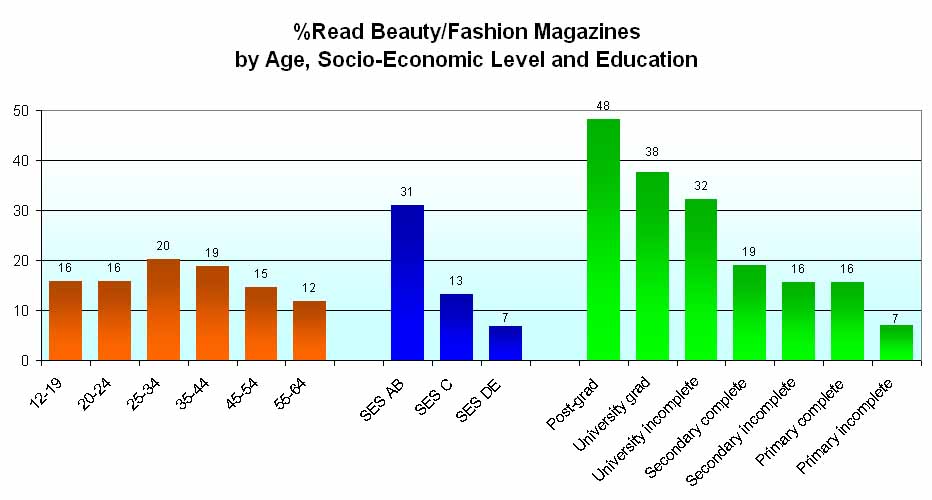
(source: 2004 TGI Brasil)
Fashion Magazine Readers in Brazil
If one picks up a beauty/fashion magazine such as Vogue, one may come away with the impression that the magazine is in fact a catalog for products and services as the distinction between advertisements and editorial content seems blurred. From Michelle Lee's Fashion Victim (page 99):
The lovey-dovey relationship between the media and fashion businesses creates a dangerous sitaution in which a few supposedly impartial media outlets pitch products. Some major magazines have been known to purposely ignore the proper separation between editorial and advertising, giving preferences and sometimes extra coverage to adverisers -- the people who pay their bills. A fashion editor I used to work with was notorious around the office for trying to plug advertisers into editorial features. It's no wonder that designers want to convince editors to show their products in the feature pages -- it's free advertising that's endoresed by the fashion experts at the publication. "People have said to me that being mentioned in In Style is like having a license to print money," says People's Martha Nelson. One time, Nelson recalls, the magazine showed a handbag by a fledgling designer in a wedding story. "The designers wrote me a letter that said, 'If you see the tears on this page they are the tears of happiness that I'm feeling because of the huge response that I've gotten,'" says Nelson. "The bag was about $250, and she had gotten 2,000 orders. Do the math for a small business and think about someone making these in her spare room."
We will now refer to some survey data from the 2004 TGI Brasil study. This is a survey of 5,312 persons between the ages of 12 to 64 years old in Brazil interviewed during the first half of 2004. Since our subject is female beauty/fashion magazines, we will focus on the 2,857 female survey respondents. We were interested in the readers of the following monthly publications: Boa Forma, Claudia, Elle, Manequim, Marie Claire, Nova and Vogue. According to the TGI Brasil study, 17% of the survey respondents read one or more of these titles.
The next chart shows the profiles of the beauty/fashion magazine readers. They are more affluent and educated.

(source: 2004 TGI Brasil)
It is one thing to sit in an armchair and complain about media manipulation. It is something else when the reality is that this is not a one-way street in which manufacturers shovel doses of beauty and fashion sense through the media right down the throats of consumers. It is a three-way transaction among advertisers, media and consumers. The two charts below show the problem -- the advertisers know that these magazines work for them because their products sell; the magazines know that they are serving to link advertisers and consumers; and the consumers rely on these magazines to give them the information to stay beautiful and fashionable. It would require a social revolution to overturn this arrangement.

(source: 2004 TGI Brasil)

(source: 2004 TGI Brasil)
(posted by Roland Soong, 11/02/2004)
(Return to Zona Latina's Home Page)